Cooking Vegetables:
Blanch Boil Steam Sauté Braise Roast Sir-Fry Grill Microwave Cooking TimesHere are some of the most common methods for cooking vegetables.
Blanch:
Blanching consists of taking a fruit or vegetable and plunging it into boiling water for a brief interval then taking it out and putting it straight into iced water (shocking it) to stop the cooking. Normally, green vegetables will turn bright green and remain fairly crisp. Fruits and tomatoes are sometimes blanched to remove their skins. Blanched vegetables make a good addition to any vegetable platter (crudités ) served as an appetizer. Carrots and celery sticks are the usual choices, however, other vegetables like broccoli, cauliflower, snow peas and asparagus are sometimes included but do not taste that good when served raw. Blanching can really improve their appeal. Here's the process;
- Cut the veggies into snack size pieces.
- Bring salted water to a rolling boil. There should be enough water so that it does not stop boiling when the veggies are added. It can be salty as sea water, 1-2 Tbsp. for 4 quarts of water.
- Have a bowl of ice water ready, a slotted spoon or course strainer and a plate lined with a dish towel or paper towels.
- Cook one kind of vegetable at a time, starting with the lightest color first and saving the dark colors for last. Add the veggies to the water. After 30 seconds check if they are done. Green vegetables will turn bright green when they are done. Some vegetables may take up to 2 minutes. They should still be crisp and not overcooked to the point of turning dull green.
- When the veggies are done, remove them to the iced water.
- When cooled, move them to the towel lined plate.
Boil:
For those who grew up on a Western diet, this was perhaps the most common method in previous generations. Vegetables were covered in water, boiled until done then the water was drained and discarded. Vegetables were often served with a little melted butter as a side dish to a meat and potato meal. Since most of the nutrients go down the drain with the boiling water, this method is not recommended. For plain vegetables, steaming is the preferred method. For potatoes however, boiling is preferred. Boil potatoes whole with skins for fries, potato salad, soups etc. or peeled and cut up for mashed potatoes. For cooking details, see Potatoes.
TopSteam:
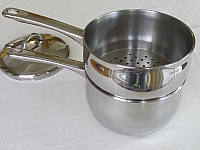 For a quick side of plain vegetables steaming is the best. It cooks quickly, uses a small amount of water so it is energy efficient and most nutrients are retained. Vegetables can be either fresh or frozen. Since this method is used so often, it is worth it to invest in a good steamer pan assembly. The commonly used collapsible steamer baskets are flimsy, difficult to clean and when the vegetables are done it can be difficult to move them to a serving dish. The process is very simple;
For a quick side of plain vegetables steaming is the best. It cooks quickly, uses a small amount of water so it is energy efficient and most nutrients are retained. Vegetables can be either fresh or frozen. Since this method is used so often, it is worth it to invest in a good steamer pan assembly. The commonly used collapsible steamer baskets are flimsy, difficult to clean and when the vegetables are done it can be difficult to move them to a serving dish. The process is very simple;
- Fill the base pan with about an inch of water.
- Add the vegetables to the perforated insert pan and cover.
- Bring the water to a boil. When boiling well, turn the heat down to a low boil (5). This will reduce the risk of boiling the water dry.
- Check the vegetables occasionally to see if they are done. For most vegetables this will be between 3 to 12 minutes. I don't time vegetables but go by their color or stick them with a fork. Green veggies will first turn bright green then as soon as they turn a duller green they are done. Remove immediately to a serving dish. If they are left in the pan even with the heat off, they will overcook.
- Try tossing with a sprinkle of olive oil instead of the traditional butter. A little oil will aid in the absorption of beta-carotene other fat soluble vitamins.
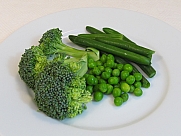 |
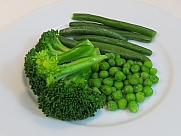 |
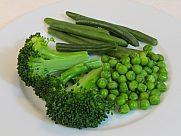 |
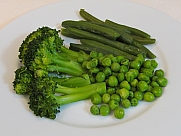 |
|||
| Raw veggies | Bright green, crisp | Just right, cooked | Dull green, overcooked |
Sauté:
Sautéing is commonly used when the vegetable dish will include onions, mushrooms, garlic or spices. They are usually sautéed first then when they are done, the main veggie is added. If the dish is then covered, it can also use the moisture from the vegetables to steam them. A typical sequence is;
- Heat a stainless steel frying pan to a medium heat (4). Add a 1-2 Tbsp of oil. Canola, olive or peanut oils are the most common choices. Oil should be heated to the shimmering point but never to the smoking point. If the oil smokes, throw it out and start over.
- Depending on the dish, the sequence may vary. Indian dishes usually add spice seeds first (cumin, mustard, etc.) until they crack. If mushrooms are being used, they are usually sautéed first since they have a very high moisture content. After about 5 minutes when most the moisture has boiled off and the mushrooms are browned other veggies are added. Onions are commonly sautéed first until they are translucent before other veggies are added. Garlic comes next, after the mushrooms/onions but before the main veggies. It cooks quickly, in about a minute. The main veggies should be added before it browns.
- Add the main veggies. Cover if a steaming effect is desired. Move them around every minute or two. Either flip them using a back and forth motion that rolls them off the curved edge of the pan or stir them around with an appropriate utensil.
- Veggies are done when they turn slightly dull green or are soft when pierced. Move them right away to a serving dish.
Braise:
Braising is a technique where the item to be cooked is partially submerged in a liquid, covered and then simmered slowly at a low temperature. It is commonly associated with cooking meat however in this context, with vegetables, it means cooking without oil, in a small amount of water or broth and when the veggies are done the liquid is then boiled off. Therefore, close attention should be paid so that the veggies don't get scorched when the liquid boils off. Since, the liquid is not drained off, nutrients are retained. In some cases, ingredients may be sautéed or seared first before the liquid is added. This is the best method for mashed sweet potatoes. Unlike regular potatoes, sweet potatoes will fall apart and get mushy if peeled, cut into pieces and then boiled. On the other hand, sweet potatoes with their skins on hold up better to boiling but then they will need to be peeled afterwards. I prefer peeling the raw potato in the beginning rather than juggling with a hot potato at the end.
TopRoast:
Roasting uses the oven, to bake vegetables using a very high heat, over 400 degrees, giving them a crusty or browned outer layer. Their flavor becomes concentrated and their natural sugars caramelize.
- Adjust the oven rack to middle position and preheat the oven to 400-450 degrees according to recipe requirements.
- Cut the vegetable into same size pieces. You can roast different veggies together if their cooking times are similar.
- Coat the vegetables in a little bit of oil and optionally some salt, pepper and/or herbs. This can be done by mixing the oil (usually about 2 Tbsp of olive oil) and spices in a bowl then tossing the veggies in the bowl. Rosemary is a commonly used spice.
- Spread the veggies evenly out on the baking sheet. They should be in a single layer with spaces in between.
- Cooking times will vary depending of the vegetable. Artichokes could be 15-20 minutes, root vegetables could be over an hour.
- Typically, veggies will need to be flipped half way through their cooking time.
Stir Fry:
See video Stir Frying 5:11 minutes
TopGrill:
Grilling can be done outdoors on a BBQ grill or inside on the stovetop using a cast iron grill. The cooking process is the same.
- Cut vegetables into ¼" to ¾" slices to maximize surface area. The most commonly used vegetables include zucchini, summer squash and eggplant. Other popular choices are bell pepper, mushroom, asparagus, onion and of course corn on the cob. Threading veggies of similar size and cooking time on a skewer to make a kabob is another great option.
- Lightly toss or brush the veggies with olive oil. Optionally, sprinkle with salt. Additionally, herbs such as basil, oregano, thyme etc. can be mix in the oil used for coating. Or try making a marinade sauce with the oil and let the veggies soak for an hour or so in a sealed plastic bag or container.
- Heat the grill to medium heat.
- Place the veggies in a single layer on the grill. Flip when ready using tongs.
Microwave:
I generally use the microwave only for short bursts, usually to reheat food. But it can be run for longer periods to do the main cooking that would normally be done on the stovetop or in the oven.
- Place the cut vegetables in a microwavable dish (non-plastic) or Pyrex bowl. Use one kind of vegetable at a time.
- Except for potatoes, add some water (see table below).
- Cover with a plate or non-plastic lid.
- Microwave on high until done. See table below for times.
Cooking Times:
| VEGETABLE | AMOUNT | STEAM | MICROWAVE | ROAST |
| Asparagus | 1 pound | 3 - 5 | 4 - 6 3 Tbsp water |
10 - 15 |
| Beets | 1½ pounds (6 medium) |
40 - 55 | 18 - 24 ¾ cup water |
60 |
| Bell Peppers | 2 pounds 1" wide strips |
6 - 8 | 4 - 6 | 30 |
| Broccoli florets |
1½ pound | 5 - 6 | 4 - 6 3 Tbsp water |
10 - 15 |
| Brussels Sprouts | 1 pound | 8 - 10 | N/R | 10 - 20 |
| Butternut Squash 1" pieces |
2 pounds | 12 - 14 | 10 - 12 ¼ cup water |
40 |
| Carrots ¼" slices |
1 pound | 5 - 6 | 4 - 7 2 Tbsp water |
30 - 40 |
| Cauliflower florets |
2 pounds (1 head) |
7 - 9 | 4 - 7 ¼ cup water |
20 - 30 |
| Eggplant | 2 pounds (2 medium) |
N/R | N/R | 20 - 25 |
| Green Beans | 1 pound | 6 - 8 | 4 - 6 3 Tbsp water |
20 - 30 |
| Peas | 1 pound | 4 - 6 | 3 - 6 3 Tbsp water |
N/R |
| Potatoes unpeeled, whole |
2 pounds (4 medium) |
N/R | 8 - 12 no water |
45 (2" pieces) |
| Sweet Potatoes peeled, 1" cubes |
2 pounds (3 medium) |
12 - 14 | 8 - 10 ¼ cup water |
30 |
| Zucchini | 2 pounds | 5 - 10 | 4 - 6 2 Tbsp water |
15 - 20 |

Post a Comment